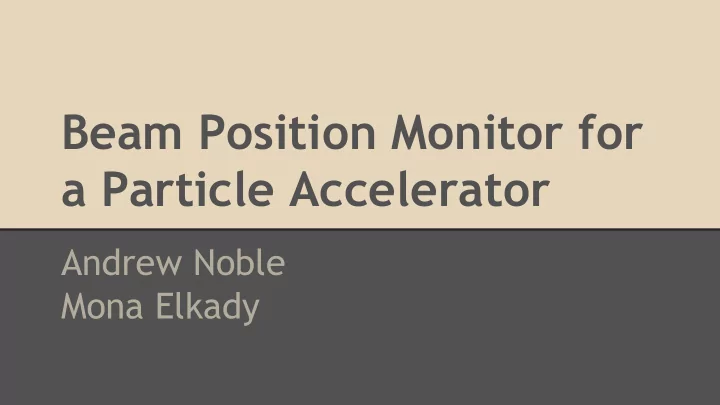

Beam Position Monitor for a Particle Accelerator Andrew Noble Mona Elkady
Overview ● Free Electron Lasers and Particle Accelerators ● Beam Position Monitors ● Pulse Generator ● Sample and Hold Circuit ● PCB Design
FELs and Particle Accelerators ● Particle Accelerators Use strong electric fields to accelerate a beam of particles to ○ relativistic speeds ● Free Electron Laser (FEL) Uses electron beam created by particle accelerator to create ○ tunable electromagnetic radiation source: http://www.lightsources.org/what-free-electron- laser
Beam Position Monitors (BPM) Beam Position Monitors ● Measure the location of the electron beam within the accelerator tube ● Ensure the functioning of the particle accelerator by centering the beam through the use of corrector magnets What are we doing differently? Source:http://durpdg.dur.ac.uk/vvc/accelerators/bpm.html
Sample and Hold Sample and Hold Circuits ● Samples data ● Holds that data until it can be processed Source:http://en.wikipedia.org/wiki/Sample_and_hold#mediaviewer/File:Sample-hold-circuit.svg
Sample and Hold Requirements ● Needs to have a high open loop gain We are trying to measure the beam position on the order of tens of ○ micrometers which means we need at least 10,000 V/V open loop gain ● Needs a high enough bandwidth The pulses that can be measured in a particle accelerator can have a ○ pulse width on the order of picoseconds (extremely fast) It isn’t reasonable to design a sample and hold with a bandwidth ○ that large We will be implementing a pulse stretcher to reduce the bandwidth ○ requirements
Pulse Generator Last year’s schematic Analyzed: - MOSFET vs. BJT - DC Converter vs. Boost Converter
Final Pulse Generator Schematic Changes to last year’s schematic. The change in the converter allows for a range of 10-14V input and 55 to 135 V output.
Final Pulse Generator Circuit Final circuit Wiring on back of circuit Result of circuit
PCB Design Goal: To create a PCB of our pulse generator to have a solid prototype with no loose ends. Constraints ● Size ● Cost ● Accuracy of custom parts
PCB Process: Schematic
PCB Process: Footprints PCB footprint before changing some of the parts and rearranging everything around.
PCB Footprints After Changes
Budget Purchased Items Description Cost ($) Quantity Part Number Sample and Hold Op- 39.57 1 AD585AQ Amp Total Cost = $ 39.57
Conclusion While there is still some work to be done to complete the design, such as settling on a final sample and hold design, implementing an A/D converter, and creating the code to display the sampled information; we are currently on track for designing a low cost single channel BPM for implementation on particle accelerators. Are there any questions?
References - Max VanKeuren and Stephen Watras. (2014) Beam Position Monitor for CSU Accelerator Laboratory. Retrieved from http: //projects-web.engr.colostate.edu/ece-sr-design/AY13/beam/Documents/FinalReport.pdf
Recommend
More recommend